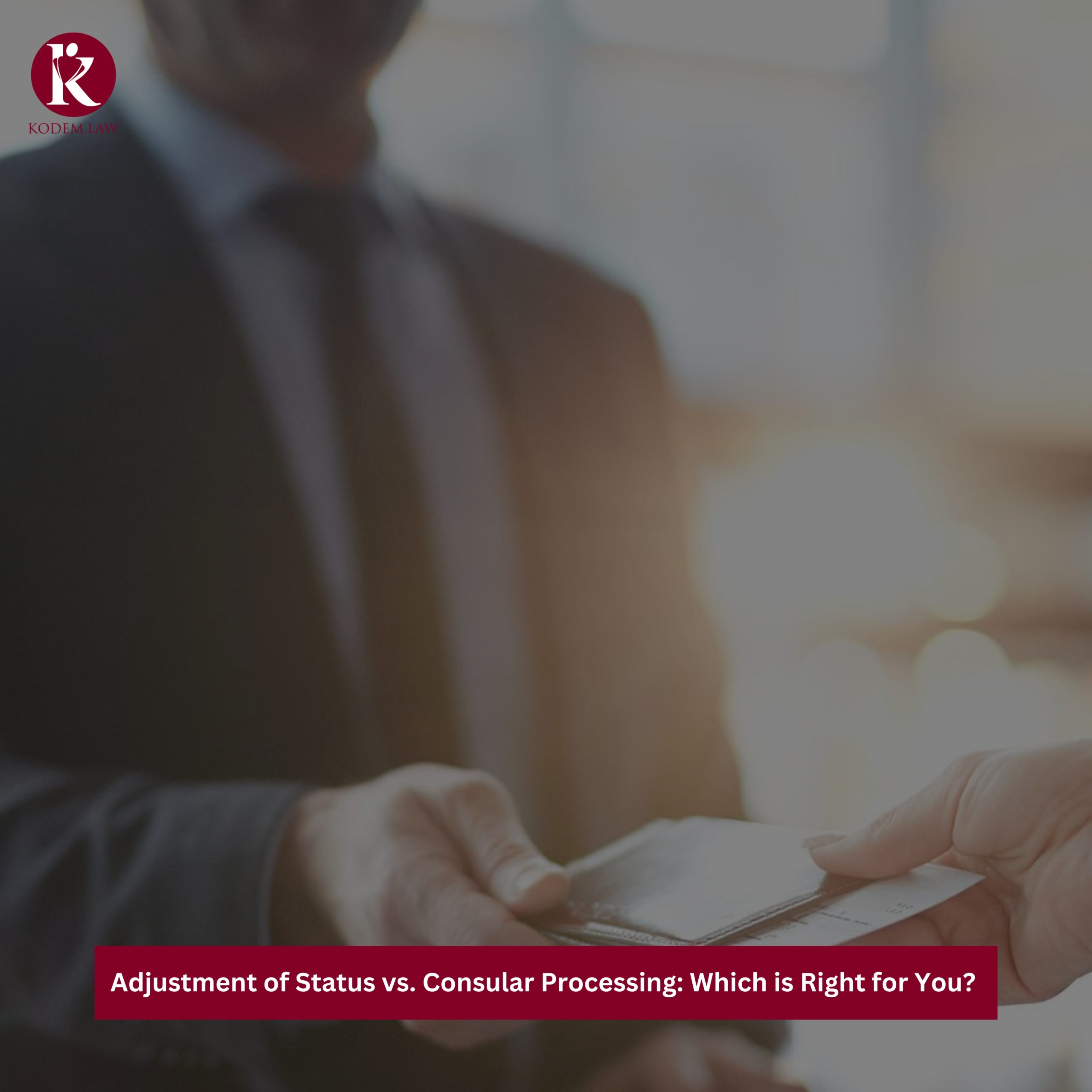
When applying for a U.S. green card, you can choose Adjustment of Status vs. Consular Processing. Both lead to permanent residency but differ in timelines, procedures, and suitability based on your circumstances. Understanding each option helps ensure a smooth green card process.
Choosing the right path is essential to ensuring a smooth journey toward obtaining your green card.
Understanding Adjustment of Status (AOS)
Adjustment of Status is the process that allows individuals already in the United States to apply for a green card (permanent residency) without having to leave the country. Unlike other pathways that require you to apply from outside the U.S., AOS lets you complete the entire process while staying within the U.S., making it a more convenient option for those who qualify.
What is the Eligibility Criteria?
- Physical Presence in the U.S.: You must be physically present in the United States at the time of applying for AOS. This means that if you are currently outside the U.S., this option isn’t available to you.
- Lawful Entry into the U.S.: To be eligible for AOS, you must have entered the U.S. legally, such as with a valid visa or through a recognized port of entry. Entering unlawfully (e.g., without inspection or proper documentation) typically disqualifies you from this process.
- Eligibility for an Immigrant Visa: You must also meet the criteria for a specific immigrant visa category (e.g., family-based, employment-based, etc.), meaning you need to have a valid basis for applying for permanent residency. This usually involves having a petition approved by U.S. Citizenship and Immigration Services (USCIS), such as a family member or employer sponsoring you.
Key Benefits and Drawbacks of Adjustment of Status
1. Benefits
- Remain in the U.S. during processing: One of the biggest advantages of a adjustment of status is that you do not need to leave the United States while your green card application is being processed. This eliminates the need to travel back to your home country for visa interviews, providing peace of mind for those who wish to continue living, working, or studying in the U.S. without disruption.
- Access to work authorization and travel permits: While your AOS application is pending, you can apply for work authorization (Employment Authorization Document or EAD) and a travel permit (Advance Parole). This allows you to legally work in the U.S. and travel internationally without abandoning your application, giving you more flexibility and stability during the waiting period.
2. Drawbacks
- Lengthy processing times: One downside to AOS is that it can take several months or even over a year for your application to be processed. During this time, there may be uncertainties, and you’ll need to be patient as USCIS reviews your case.
- Travel complications without advance parole: If you need to travel outside the U.S. while your AOS application is pending, you must obtain advance parole, a special travel document. Traveling without it can lead to your AOS application being considered abandoned, meaning you may not be allowed to return to the U.S. or continue your green card process. This can cause unexpected delays or even disqualification from the process.
Note: Overall, while AOS offers significant benefits like staying in the U.S. and obtaining work and travel permits, it also requires careful planning, especially regarding travel.
Overview of the Adjustment of Status Process
♦ Step-by-step Overview
- File Form I-485 (Application to Adjust Status)
- Submit supporting documents (e.g., proof of eligibility, medical exam results)
- 3. Attend a biometrics appointment
- 4. Wait for the green card interview
- 5. Receive a decision
♦ Common Forms and Documents:
- Form I-485
- Form I-130 (for family-sponsored)
- Supporting evidence (passport, birth certificates, etc.)
♦ Processing Times and Outcomes:
Processing times vary, typically taking 8-14 months. Outcomes range from approval, requests for more evidence, or, in some cases, denial.
Understanding Consular Processing
Consular Processing is an alternative to Adjustment of Status (AOS) for those seeking a U.S. green card. Instead of applying from within the United States, applicants must return to their home country and complete the process through a U.S. embassy or consulate.
What are the Eligibility Criteria?
- Outside the U.S.: Applicants must complete the green card process from outside the United States at a U.S. embassy or consulate.
- Immigrant Visa Eligibility: You must be eligible for an immigrant visa, based on family sponsorship, employment, or other qualifying factors.
Key Benefits and Drawbacks of Consular Processing
1. Benefits
- Often faster processing: Consular Processing may be quicker than AOS, depending on the country and the workload of the consulate. This can be an advantage if time is a significant factor in your case.
- No need for advance parole: Unlike AOS, there’s no need for a special travel document, as you’re already outside the U.S. during the application process. Once approved, you can enter the U.S. as a permanent resident without complications.
2. Drawbacks
- Travel requirements: Consular Processing requires applicants to leave the U.S. for an interview at a U.S. embassy or consulate. This can be challenging for those who are already in the U.S. or have family and work obligations there.
- Potential travel delays and expenses: Traveling abroad for consular interviews can be costly, especially if unexpected delays occur. After the interview, there might be visa processing delays, which can prevent you from returning to the U.S. as quickly as you planned.
Note: Overall, Consular Processing may offer faster results, but it also involves the inconvenience and costs of traveling outside the U.S. This method is best suited for individuals who are currently abroad or who don’t mind leaving the U.S. for a period during their green card process.
Overview of Consular Processing
♦ Step-by-Step Overview
- File the necessary immigrant petition (Form I-130 or I-140)
- Wait for approval from USCIS
- Complete DS-260 (immigrant visa application)
- Attend a consular interview abroad
- Receive a decision
♦ Common Forms and Documents
- DS-260
- Proof of eligibility (birth certificates, marriage licenses)
- Affidavit of support, if needed
♦ Processing Times and Outcomes
Consular processing generally takes 6-12 months. After the interview, successful applicants receive an immigrant visa, allowing them to travel to the U.S. and become a permanent resident.

Adjustment of Status Vs. Consular Processing
Criteria | Adjustment of Status (AOS) | Consular Processing |
Location | Processed within the U.S. | Processed at a U.S. consulate/embassy abroad |
Timeline | Typically takes longer due to internal processing | Generally quicker, but requires travel for an interview |
Residency Status | Must be physically present in the U.S. | Typically for individuals applying from outside the U.S. |
Work Authorization | Can apply for work authorization during the process | Work authorization is not granted until after green card approval |
Travel Restrictions | Travel outside the U.S. restricted without advance parole | Free to travel until visa interview is scheduled |
Interview | Interview usually within the U.S. | Interview required at a U.S. consulate/embassy |
Eligibility Requirements | Must have lawful entry and be eligible for an immigrant visa | Must be eligible for an immigrant visa |
Travel Costs | No international travel required | Must travel to a U.S. consulate abroad, leading to travel expenses |
Processing Complexity | May be complex due to overlapping U.S. immigration processes | Typically more straightforward with consular requirements |
Preferred for | Individuals already in the U.S. | Individuals outside the U.S. or those who travel frequently |
Common Challenges and Effective Solutions for Adjustment of Status and Consular Processing
Here are the key challenges and solutions associated with Adjustment of Status vs. Consular Processing:
Adjustment of Status (AOS) Challenges:
- Processing Delays: USCIS backlogs can result in longer-than-expected processing times. To overcome this, regularly check your application status online, plan for potential delays, and seek assistance to expedite your case if necessary.
- Travel Restrictions: Traveling outside the U.S. can complicate your application if you do not have advance parole. To avoid issues, apply for advance parole well in advance of any anticipated travel, align your travel plans with your application timeline, and consult an immigration attorney to ensure compliance.
Consular Processing Challenges:
- Visa Denial Risk: There is a risk of visa denial, which may require you to remain abroad until any issues are resolved. To mitigate this risk, ensure that all your documents are accurate and complete before your consular interview, and work with an immigration attorney to prepare thoroughly and address any potential issues in advance.
- Processing Time Variability: Processing times can vary significantly depending on the U.S. consulate and your individual circumstances. To navigate this, be prepared for potential variations, maintain communication with the consulate for updates, and ensure that all required documents are gathered and your application is thoroughly completed to avoid delays.
How Kodem Law Can Help You?
If you face complications with your immigration case, need help understanding your eligibility, or want to ensure your application is completed correctly, consulting an immigration attorney is crucial. At Kodem Law, our experts provide the guidance needed to navigate complex immigration processes effectively. Choosing a specialist from our team, with expertise in family-based or employment-based immigration, ensures your case is handled with precision. Our experienced attorneys are dedicated to resolving issues efficiently and avoiding costly mistakes, giving you greater confidence and ease throughout the process.

